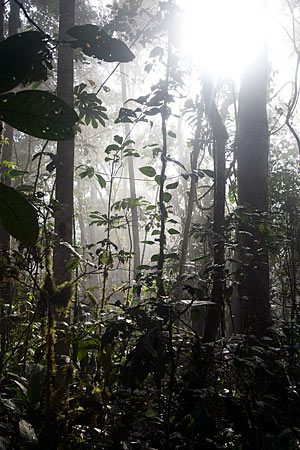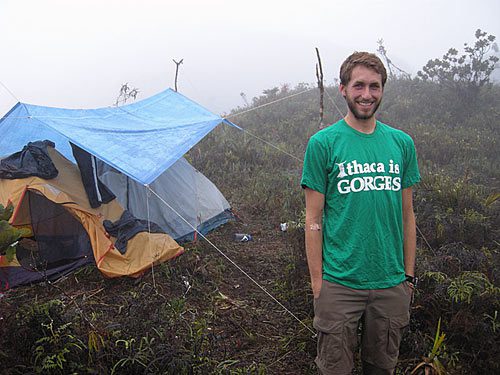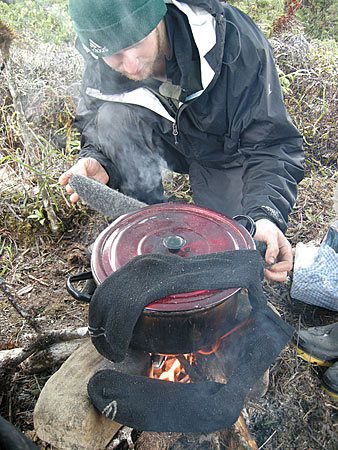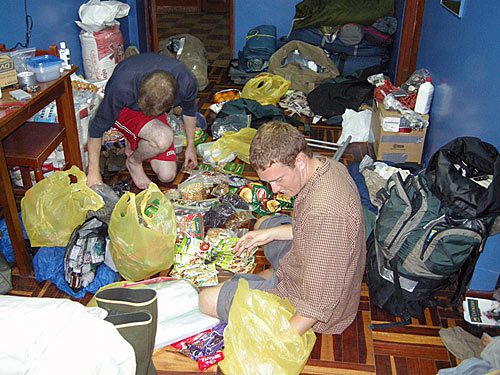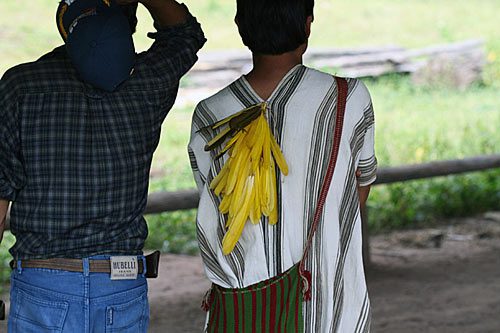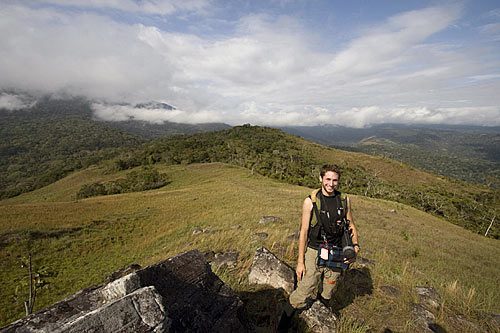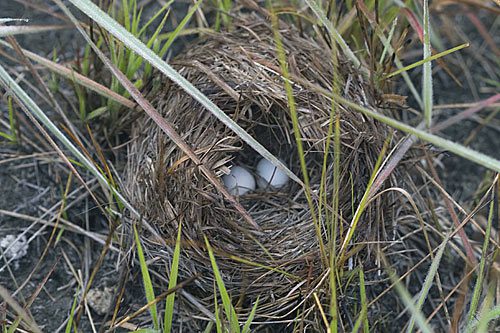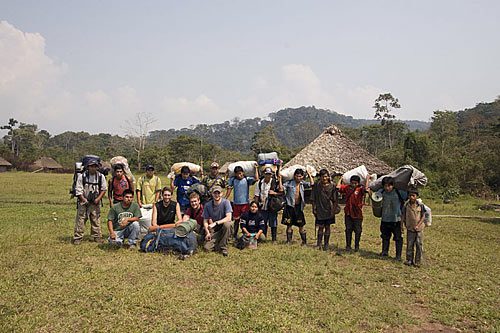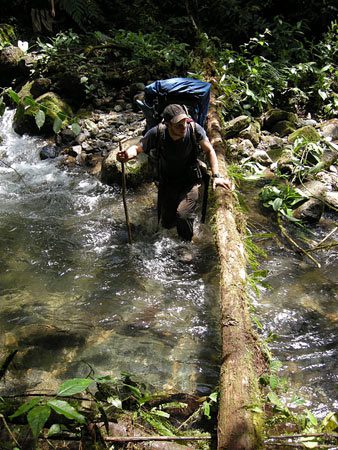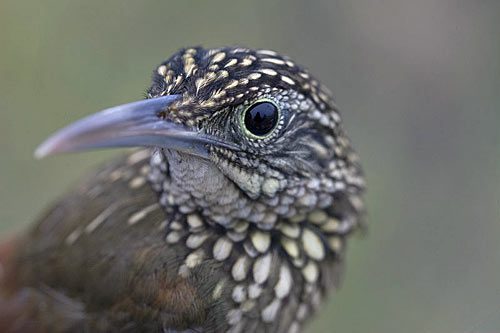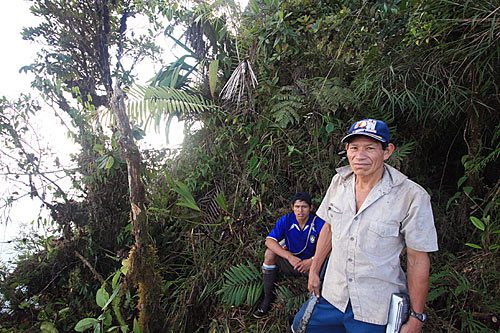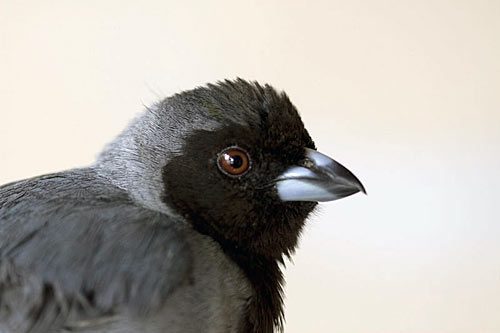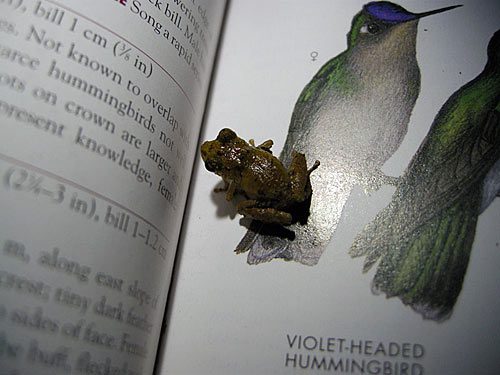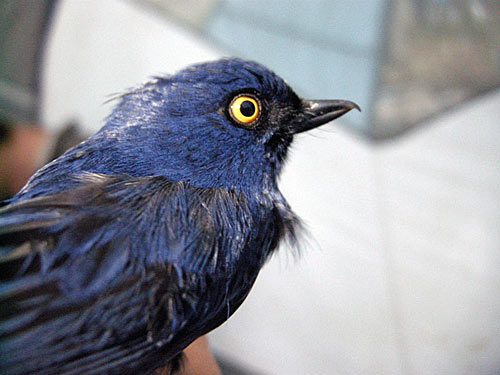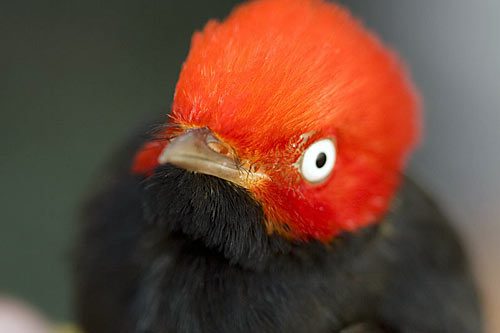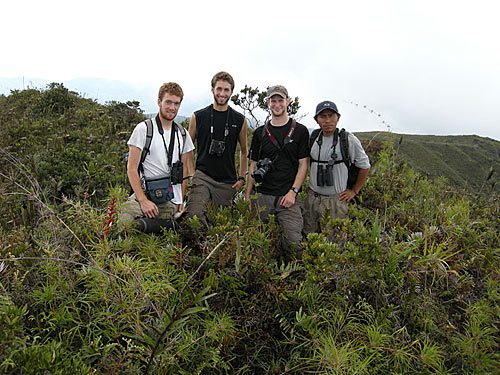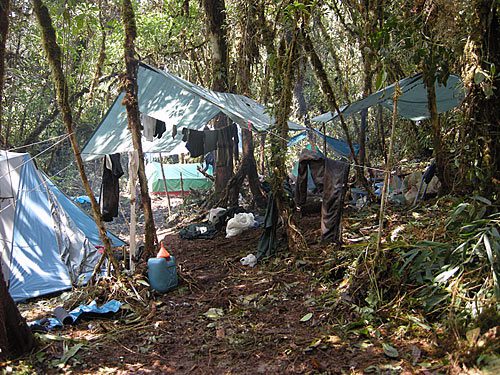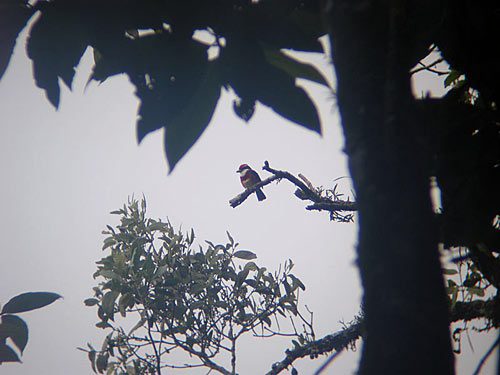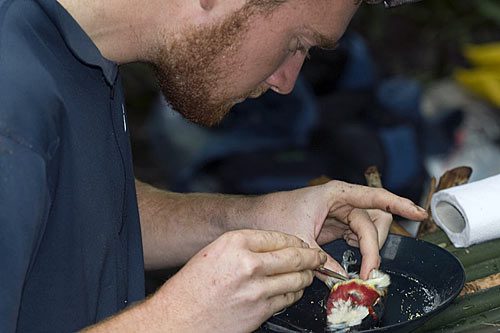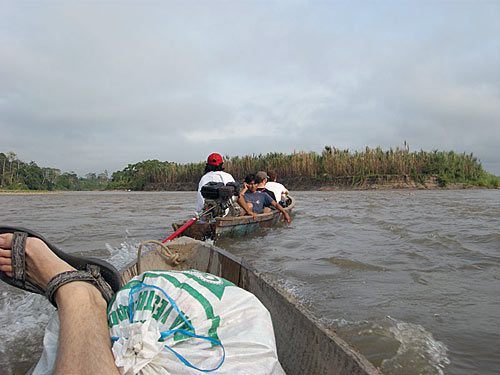Stretching the Canvas: A Modern-Day Species Discovery in Peru
By Hugh Powell; Photographs by Glenn Seeholzer and Ben Winger April 15, 2010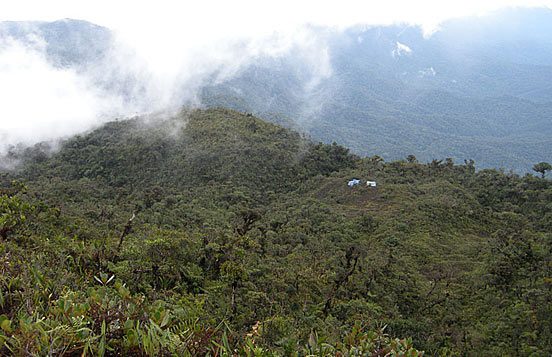
The porters had turned back a week earlier. It was now an expedition of seven people: biologists Ben, Glenn, Mike, and Daniel; their two guides, Eusebio and Elvis; and their cook, Luz. They were alone in the Peruvian cloud forest, camped under the shadow of a peak called Menkoremon. They had run out of sugar five days ago, and Elvis, the group’s designated marksman, was down to one shotgun shell.
But they had come to survey birds, and so the next morning, October 8, 2008, they headed out along the makeshift trails Eusebio had cut with his weathered machete. As Mike and Glenn passed under a gap in the canopy, Mike squinted upward and stopped short, boots squelching in the red mud. About 60 feet up on a bare branch was a chunky bird the size of a starling but the shape of a linebacker. Pale below, darker above, with a scarlet band across the breast.
In a moment, they knew it was a barbet, a downsized relative of the toucans. Mike at first identified it as Capito wallacei, the bird on the cover of the Birds of Perufield guide, a spectacular but obscure species that had been discovered only in 1995, about 300 miles to the north. For a moment they stared. Glenn raised his camera and snapped seven photographs, each time zooming closer on the bird’s heavy, silvery bill and scarlet flanks. Then Mike called to Elvis, urging him to shoot the bird as a scientific specimen.
He wasn’t being cavalier, and he wasn’t joking. Even today, these specimens are central to the task of understanding and comparing species, and they’re the only way to preserve animals for questions no one has yet thought to ask. As it turned out, the barbet Elvis shot that day was an undescribed form—a new race and possibly a new species—and an example of why scientists still collect specimens.
The discovery became the highlight of a trip that would have been a success even without it. The four young biologists had accomplished the first ornithological survey ever conducted of Peru’s Gran Pajonal region. The two-month expedition identified 670 species, documented a dozen significant range extensions, and added 490 audio recordings to the holdings of the Cornell Lab’s Macaulay Library. The data they recorded represented science’s first glimpse of the biogeographic makeup of this remote splinter of tropical highlands.
But between that shotgun blast and their safe return lay another three weeks fraught with injuries, rain, bushwhacking, and delicate negotiations in three languages. By the expedition’s last week, the four sat hunched in a cramped room in the river town of Atalaya, trying to plan a way back to their discovery.
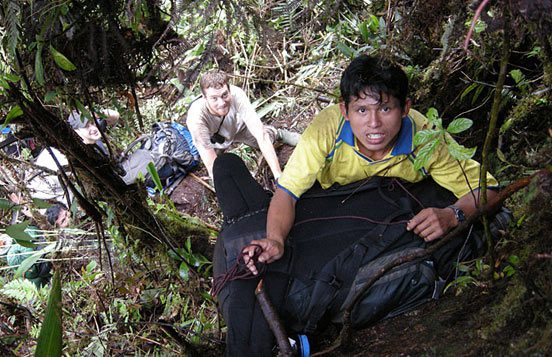
It was a young expedition. None of the four leaders—Ben Winger, Glenn Seeholzer, and Mike Harvey (who recently graduated from Cornell), and Daniel Caceres (who recently graduated from the Universidad Nacional de San Agustín in Arequipa, Peru)—were older than 23, though all of them had previous tropical field experience. They’d first come to Peru as birders, but on this trip they approached it as scientists studying how the birds fit together into communities.
The allure of exploration had taken hold of them years earlier, when Ben, Glenn, and Mike had each read A Parrot Without a Name, a grand tale of field ornithology set in the Amazonian lowlands of Peru. The book, by Don Stap, follows a setback-plagued collecting expedition mounted by John O’Neill, of Louisiana State University, in 1987. It combines the bug-bitten, sweat-stained reality of tropical field work with the sense of imminent discovery that comes with it, and it exalts the pursuit of basic biology— stretching the canvas of the known to its farthest extent.
It doesn’t hurt that the subplot of the book is a personal look into the mythology of Ted Parker, often described as the “Michael Jordan of birding.” A tropical biologist who knew more than 4,000 birds by sound alone, Parker died tragically in a plane crash in 1993 at the age of 40, no less a wunderkind than he had been as an undergraduate 20 years earlier. For three birders from Cornell, there were worse people to model their aspirations after than O’Neill and Parker. By their senior year at Cornell, Mike, Glenn, and Ben knew they wanted to mount their own expedition but weren’t sure where. The Andes drew their interest for its innumerable microclimates nestled among ridges and river gorges. In such isolated pockets, steady year-round temperatures give birds a strong incentive to stay put, and unusual communities develop.
For advice they turned to three ornithologists who had worked in Peru for decades: Cornell Lab director John Fitzpatrick, research associate Tom Schulenberg (lead author of Birds of Peru), and Louisiana State University’s John O’Neill himself. In their discussions, O’Neill pointed out the Gran Pajonal region, 250 miles northeast of Lima. It’s a pyramid of low mountains, sitting alone, sharp-sided as a wedge of Parmesan, on the east side of the Andes. The Gran Pajonal had been visited by botanists, anthropologists, and oil speculators, but never by ornithologists. The area seemed ripe for exploration.The Gran Pajonal lay 3,700 miles due south of their starting point in Ithaca, New York, and the young biologists planned to be in the field for two months.Packing is always a matter of deciding what you can’t do without and then living with the consequences. The flip side is taking too much, and its punishment is the mountain of duffels and packs that, day after day, must be tediously dismantled, carried, and reconfigured in a forest clearing. By late August 2008, the team’s Ithaca living room looked as if a small warehouse had exploded inside it. And all of it seemed essential: maps, GPS units, audio recorders, microphones, batteries, a laptop, a generator; reference books, binoculars, cameras, iPods, notebooks; water purification tablets, first-aid kits, cook kits, skinning kits, rain gear, duffel bags, dry bags, sleeping bags; backpacks, tents, tarps, headlamps, lanterns, folding chairs, preserving alcohol, flagging tape, duct tape, rubber boots, insect repellent.
Somehow it all fit into the SUV they drove to JFK airport, and then into the taxi in Lima, Peru, that took them to meet Daniel. From there a bus carried the whole mess across the Andes; a red Toyota pickup took it to the Peruvian frontier and over the wide Río Perene on a makeshift ferry; and finally into Oventeni, a town of a few hundred people in the dry grasslands of the Gran Pajonal, where the road ends.
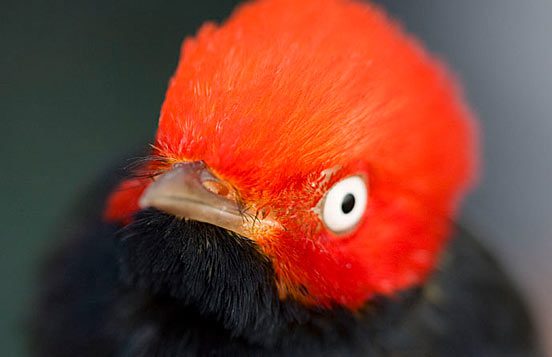
The first thing they noticed was that the birds were spectacular. “The best two hours of birding in my life,” is how Glenn described their first morning in Oventeni. They quickly found Wedge-tailed Grass-Finches—lanky, raggedy-tailed, sparrowlike birds previously unknown within 350 miles.
“It was like a figment of our imagination was suddenly confirmed, and the bird materialized off the plates of the field guide,” Ben recalled in an email sent during a resupply trip. “Our findings underscored the degree to which this region is unexplored by ornithologists. Within two hours, we had found new populations of four localized species that are only known in Peru from a few other dry valleys throughout the eastern Andes: Rusty-backed Antwren (Formicivora rufa), Spot-tailed Nightjar (Caprimulgus maculicaudus), Wedge-tailed Grass-Finch (Emberizoides herbicola), and Cinereous-breasted Spinetail (Synallaxis hypospodia). Even better, we encountered a few individuals of Plumbeous Seedeater (Sporophila plumbea), a bird only known in Peru from the Pampas del Heath on the Peru-Bolivia border.”
Later that morning, under a palm-thatched pavilion, they laid out their itinerary to local leaders, some of whom were wearing jeans and T-shirts, others traditional cushma robes and strings of yellow macaw feathers. The plan was to spend a week surveying the grassland and forest near Oventeni, then resupply and begin the major leg of the expedition, a 40-mile trek across the Cerros del Sira, down to the Río Ucayali, and out by river boat. The leaders granted permission and assigned a local coffee farmer named Eusebio to be the team’s guide.
On September 17, the party left Oventeni on foot. Ahead of them Eusebio and his teenage son, Elvis, cut trail with machetes. Behind them walked their young cook, Luz. Her plastic sandals broke early on the first day, and she spent the next month hiking barefoot. Fifteen porters carried the mountain of gear and food.
The land they crossed was brutally steep. The local Ashéninka people of the Gran Pajonal use this trail to go fishing in the Río Ucayali, but they move over it quickly, single file, without mist nets or duffels. The trail teetered across slick slopes and plunged into boulder-strewn canyons. Periodically the ground vanished into greenish-gray stone cliffs heading straight up into the mist and rain. The biologists clung to vines and handed up backpacks from one person to another.
After four days of slow going, they set up an impromptu camp at a creek called Río Shaani. The forest around them was spectacular, so why not inventory some birds? They were rewarded with silver-blue Sira Tanagers (Tangara phillipsi), a threatened species previously known only from mountains 80 miles to the north. The birds turned out to be common here—good news for a rare species.
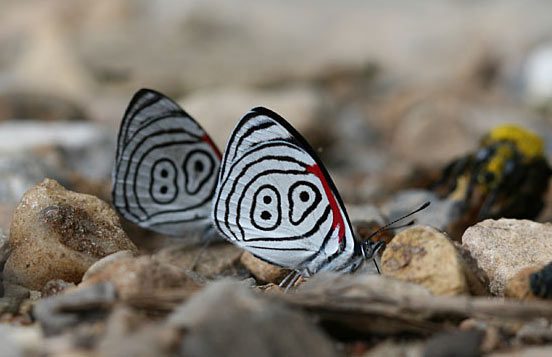
Further work turned up more indications that they had left the Amazonian communities behind and below them. They started finding more Andean birds, along with some surprises. Mike wrote: “A healthy subset of these, for example Highland Motmot (Momotus aequatorialis) and Southern Yellow-Grosbeak (Pheucticus chrysogaster), had never previously been recorded on an outlying ridge away from the main chain of the Andes. Further, some birds considered relatively uncommon on the main chain of the Andes were amazingly numerous here—species such as the two Pharomacrus quetzals, the little Barred Parakeet (Bolborhynchus lineola), and the colourful Peruvian endemic Masked Fruiteater (Pipreola pulchra). Each morning and evening, the bizarre whirring buzzes of Wattled Guans (Aburria aburri) would echo down to us from their ridge-top posts.” The cloud forest here was low, around 100 feet tall, with most trunks just a foot or so in diameter. The undergrowth was a tangle of head-high ferns and wobbly shrubs with improbably wide leaves. Vines spiraled down tree trunks or zig-zagged through space, and every surface bore a fringe of sodden moss. The temperature was in the 50s, and the leaf litter gave off the rich, fruity smell of wet mulch.
The day they found the barbet, the biologists were up for their usual 5:00 A.M. bowl of oatmeal. All three Americans by now had woolly beards and ragged hair. Daniel and Ben were nursing infections, and Eusebio was gone, headed down the trail to get supplies. Under the main tarp, socks and old T-shirts hung on sticks over the cooking fire. The biologists pulled on knee-high rubber boots and black rainjackets and shouldered their recording gear. Out on the trails Glenn, Mike, and Daniel walked alongside Elvis. A dead branch caught their eye as it crooked across a gap in the canopy, and on it hunched a broad-shouldered, barrel-chested bird. It looked a little like a “Sopranos” character buttoned into a three-piece suit.
Elvis, who was more fond of hunting motmots and guans than barbets, wasn’t keen on spending his last shell on a long shot at a little bird, but Mike urged him on, knowing how far they were from the described range of Capito wallacei.
As it turned out, Mike’s identification was wrong, and it didn’t take them long to realize it—after all, C. wallacei was right there on the cover of their field guide, and the bird in their hands was clearly different, paler on the belly and with much more scarlet on the breast and flanks. They turned it over in their hands a few times as the truth sank in. Mike carefully wrapped the bird in Glenn’s red bandanna, and they turned for camp.
Don Stap was with O’Neill in 1987 when that team discovered a new species (later named the Amazonian Parrotlet). That evening, Stap had listened to the ornithologists quizzing each other on the names of birds calling in the night. He mused: “On the drying boards on the north side of the work tent are two small parrots for which, as yet, there is no answer to such a question. This is the strangest thought of all to me. One of the most basic impulses we have is to ask the names of things. Young children associate the name of something with the phenomenon so closely that their eyes widen with fear as they say the word ‘fire,’ their faces brighten with astonishment when they point to the sky and say ‘bird.’ And if you grew up with a field guide in your pocket, you assume that every bird has a name. In the twentieth century, who would doubt this?”

In Fall 2008, Mike, Glenn, Ben, and Daniel made the first ornithological survey of the Gran Pajonal region of Peru. 
Glenn (pictured), Mike, and Ben were proud Cornell graduates with strong ties to the Cornell Lab. 
For three months they lived in the cloud forest, cooking over woodstoves and trying to stay dry. 
Theirs was an expedition into nearly unknown territory, and it required intense planning and packing. 
Their mountains of camping, surveying, recording, and specimen gear required constant attention. 
By September they were in the village of Oventeni, meeting leaders of the local Ashéninka people. 
Their first week was spent surveying the Gran Pajonal's extensive grasslands. 
They found several major range extensions, including the Wedge-tailed Grass-Finch, which they found nesting. 
The second phase struck out into nearby cloud forest, requiring the help of 15 porters. 
Exploring the forest. 
Each day the team surveyed their surroundings, finding birds such as the Ocellated Woodcreeper. 
Their guides, Eusebio and his son Elvis, proved indispensable in guiding them and talking with the locals in the Ashéninka language. 
Mist nets strung near camps turned up birds like the Black-faced Tanager. 
A tiny frog hopped onto the field guide, where it's dwarfed by a hummingbird. 
Deep-blue Flowerpiercers get at nectar by puncturing the bases with their specially shaped bills. 
Round-tailed Manakins were a common sight in the woods and in the mist-nets. 
A cold, rainy three days above treeline got the team to the top of Menkoremon peak. 
Camping in the forest was a fight against rain from above and mud from below. 
This was Mike and Glenn's first sight of the unusual barbet they found. 
Mike Harvey prepares a scientific specimen of the barbet, which proved to be fairly common in the remote region. 
The team reached the Rio Ucayali, and departed by riverboat. They are planning a return for further study.
Mike, Ben, Glenn, and Daniel, standing firmly in the 21st century, had reached that point again. When they got back to civilization they could tell their friends, their family, their Cornell professors the highlights of their trip in one quick list—all except the most significant one. The bird before them bore no handy, italicized couplet—and still doesn’t. By collecting this bird, preserving it, and placing it in a museum, Ben, Glenn, Mike, and Daniel were adhering to a scientific custom that ensures data are never lost and species are never forgotten. Though cameras can now capture plumage details by the megapixel, and PCR machines can assay DNA from just a flake of tissue, it is only by making specimens that scientists gain a full record of an animal or plant for the future.
Properly prepared museum specimens can answer the questions of a dozen specialists. Physiologists can study how the skeleton moved; an ecologist can learn the species’ diet from what its stomach held; endocrinologists can deduce its reproductive timing; morphologists can analyze feather structures; comparative anatomists can study toe arrangements and brain sizes; evolutionary biologists can establish its place in the tree of life.
By responsibly collecting a few individuals, scientists learn the boundaries that define a species as well as the way the species varies from one individual to another. And they gain snapshots of the past that can solve puzzles that may not even exist yet. This happened in the 1960s, when decades-old eggs in museums recorded how the pesticide DDT had thinned eggshells. In the 1990s, scientists learned that birds can see ultraviolet, raising the prospect that bird plumages look different to birds than they do to us. Museum specimens, waiting in drawers, allowed them to test the idea. Recently, molecular analyses of 19th-century museum specimens have even allowed scientists to look back past an extinction, to learn about the diet of the Great Auk.
From the outset, the team had come to the Gran Pajonal to put together the jigsaw puzzle of its bird communities. And now they were holding a piece that hadn’t even been in the box when they started.
The next day, the team trekked out of the highlands to the village of Corintoni, where they planned to resupply before returning. But here their luck turned: a misunderstanding about who could grant access to the land led to Corintoni leaders denying the team’s return to their camp and the gear they had left there— a devastating setback. It was the only place they knew the barbet existed.
They couldn’t walk away from such an important discovery, so they holed up in the town of Atalaya and began planning a new expedition on the fly. They looked for similarly situated forest patches a few miles downriver, browsing Google satellite maps on the town’s shaky Internet connection. After scrounging together replacement camping gear, they negotiated access from a nearby village and trekked back under the canopy.
Their new camp was slightly lower and the forest a bit taller than at the barbet camp. Still aiming to make a complete inventory, they strung up mist nets and spent the mornings recording calls. The nets brought in lots of hummingbirds— tiny Rufous-webbed Brilliants and a sicklebill with a beak like the first big hill on a roller coaster. But barbets are birds of the canopy, and rarely wind up in nets.
This time it was Ben who found the barbets, and he found them the hard way, after stumbling into a wasp’s nest. As the insects let him have it, Glenn, Mike, and Daniel moved on down the trail, and naturally, that was when Ben saw another barbet. He screamed, but the others just figured the wasps weren’t finished with him yet.
After determining that the barbets were numerous here, the team collected seven more specimens and spent a week studying their habits. The birds’ stomach contents revealed that the barbets eat largely fruit. And DNA from their tissues is now being used to determine where the bird fits into the barbet family tree. Since returning to Ithaca, the three Americans have started Ph.D. programs—Ben at the Field Museum and Glenn and Mike at Louisiana State University. The specimens cleared customs in late summer 2009 and preliminary DNA work on the barbet has begun. They are working on a formal description.
The team plans to return to the Gran Pajonal for summer 2010. No word yet on how much gear they intend to bring.
The expedition was made possible by funding from a special gift to the Cornell Lab of Ornithology, a National Geographic Young Explorers’ Grant, the Explorers Club, and donations to the Lab’s student World Series of Birding team.

All About Birds
is a free resource
Available for everyone,
funded by donors like you
American Kestrel by Blair Dudeck / Macaulay Library
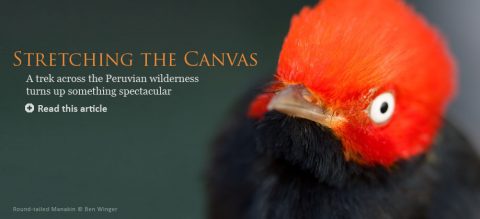



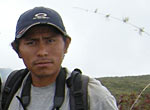 Daniel Caceres is a young Peruvian field biologist, skilled in identification of birds, frogs, and bats.
Daniel Caceres is a young Peruvian field biologist, skilled in identification of birds, frogs, and bats.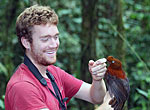 Mike Harvey is a lanky redhead who first became curious about the Gran Pajonal foothills when he saw them by riverboat on a previous visit to Peru.
Mike Harvey is a lanky redhead who first became curious about the Gran Pajonal foothills when he saw them by riverboat on a previous visit to Peru.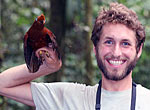 Glenn Seeholzer worked in Peru’s lowlands as an undergraduate, and that experience set him wondering about more research possibilities.
Glenn Seeholzer worked in Peru’s lowlands as an undergraduate, and that experience set him wondering about more research possibilities.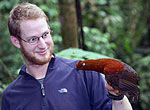 Ben Winger is given to keen observations and dry humor. He had worked in Ecuador before turning his attention to Peru.
Ben Winger is given to keen observations and dry humor. He had worked in Ecuador before turning his attention to Peru. 